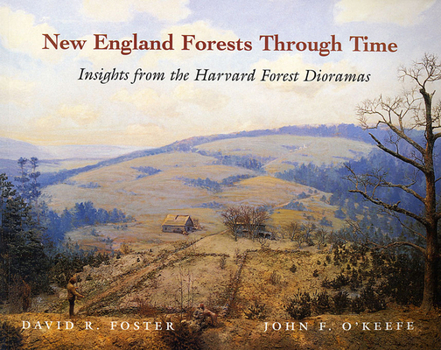New England Forests Through Time: Insights from the Harvard Forest Dioramas
Over the past 300 years New England's landscape has been transformed. The forests were cleared; the land was farmed intensively through the mid-19th century and then was allowed to reforest naturally... This description may be from another edition of this product.
Format:Paperback
Language:English
ISBN:0674003446
ISBN13:9780674003446
Release Date:August 2000
Publisher:Harvard University Forest
Length:80 Pages
Weight:0.65 lbs.
Dimensions:0.3" x 10.0" x 8.0"
Customer Reviews
4 ratings
A Long-term View of Cultural and Natural History
Published by Thriftbooks.com User , 21 years ago
This book is the result of a three-way collaboration between a scientist, a philanthropist and artist dedicated to producing a diorama depicting 300 years of New England's natural and cultural history.The work, started in the late 1920, captures the essence of the Harvard Forest approach to environmental science, in which a solid understanding of the landscape history provides a basis for interpretation and conservation of nature.Lifelike and detailed, the dioramas' historical and ecological approach remains relevant today as it becomes more apparent that changes in nature can only be assessed through long-term perspectives.
Liked Bullough's Pond? Are You Ready for Harvard's Forest?
Published by Thriftbooks.com User , 23 years ago
Many people do not realize that Harvard University has its own forest in New England. The forest has been a source of study for silviculture since its founding in 1907 for almost 100 years. In the late 1920s, Harvard professor Richard T. Fisher joined with a philanthropist, Dr. Ernest G. Stillman, and talented artisans in the studio of Guernsey and Pitman in Harvard Square to develop a remarkable series of dioramas to capture conservation issues for future generations of silviculture students to study. These dioramas are the basis for the text and illustrations in this book.New England was mostly ancient forest when the European settlers arrived. The small Native American population cleared only a modest portion of the forests, and used the game from the forests rather more than the timber. With immigration, New England rapidly became one big farm. So much for the original forests. Next, the New England farms were put out of business by richer, midwestern farms shipping their goods to the east. Within a few decades, new forests arose to cover the temporarily cleared and abandoned fields. With rapid growth in pines, a second wave of clearing occurred about a hundred years ago, leaving the forests to start to regrow again. The current hardwood-dominated forests are a result of this man-driven process. These experiences provide many lessons for understanding the impact that people have on forests, and for suggesting better practices for the future.In one sequence of seven dioramas depicting the same place over time, you can see the whole historical process take place. I found it fascinating. I recognized in each image places that I had visited in New England. Now I can connect each site to what it represents in terms of environmental circumstances. That is like learning to read nature in the way I can read a book to get a message. Today, we think ahead further (but probably not yet far enough) to consider the implications of our actions on future generations and other species. These dioramas show the importance of capturing the natural history of an area to begin to draw those lessons. Another set of dioramas were designed to exemplify the conservation issues in New England forests, including loss of old-growth forests, habitat needs for wildlife, natural losses due to hurricanes, erosion from cutting forests, imported pests that feed on forests, and the impact of natural fires and fighting forest fires. To me the most fascinating part was in the suggested good principles of forestry management. Each stage of forest growth and regrowth is displayed, along with what needs to be done for each stage. This reminded me of being asked about what to do by a client with very large holdings of forests in Maine a few years ago. If I had known about these dioramas, I could have given much more appropriate and valuable advice. I do feel quite a pang of regret at the missed opportunity, as a result. The final section of the book shows t
fascinating microcosm
Published by Thriftbooks.com User , 23 years ago
Perhaps microcosm is not quite the world, Forests Through Time offers a fascinating angle of insight into one aspect of the ecological development of New England. For a wider angle, one reads Bullough's Pond, and for the complete picture of the land in colonial times, Changes in the Land. This however is a fascinating view and well worth perusing.
Virtual Land-use History of New England
Published by Thriftbooks.com User , 24 years ago
Imagine yourself transported back in time to an ancient forest in central New England prior to settlement. As in a time lapsed movie, the ecosystem is transformed before your eyes into a subsistence farm surrounded by forest, to one dominated by prosperous farms with only remnant patches of forest dotting the land, to the forest reclaiming the abandoned farm landscape. This was part of an ubiquitous land use history that was replicated througout much of New England. The history is superbly depicted in Foster's and O'Keefe's "New England Forest Through Time: Insights from The Harvard Forest Dioramas". The narrative and photographs of the breath-taking dioramas capture the economic and natural forces that shaped the New England Landscape. The description and pictorials cover the abuses the land suffered from deforestation, overgrazing, and widespread clearcutting, and exacerbated by unnaturally high incidence of fire. The book expounds upon the different wildlife habitat associated with the changes that have occured as well as forest management techniques and current forestry issue. This book is an excellent tool for natural resource managers and educators as well as the layman who wants to know why there are apple trees, stone walls, cellar holes in the middle of the woods.




